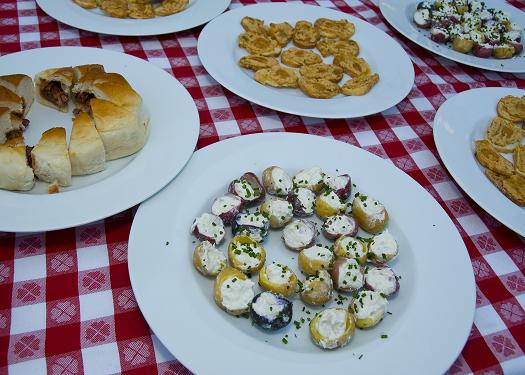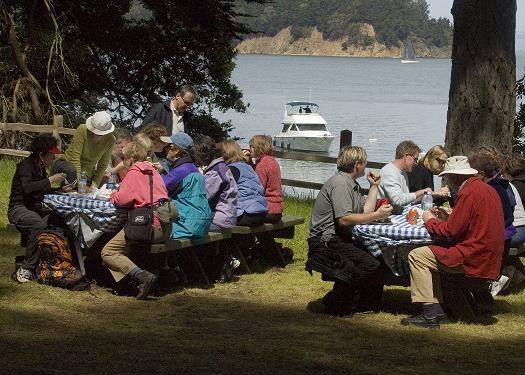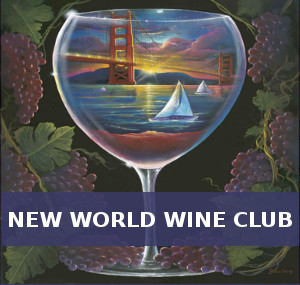Preparing food on an island is tough enough, but combine that with limited days and hours of operation and satisfying the public lands agency that oversees the island, and it’s evident why operating the food and beverage concessions at Angel Island State Park is one devil of a job.
Dee Wagner is general manager of concessions at Angel Island State Park for The California Parks Company. In addition to overseeing tram tours, bike rentals, gift sales and Segway Tours, Ms. Wagner directs a staff of up to 20 food service professionals who operate the island’s café and cantina, and cater company picnics, group outings, wedding receptions and meetings. F&B World caught up with her recently to ask how concession F&B on an island varies from operating a shoreside restaurant.
Q. What are some of the problems of preparing foods in parks and particularly on an island?
A. Vigilance and diligence is how I approach this one—absolutely everything we touch has to be brought over by boat. I do one big transportation order at the beginning of the season to bring over drinks, paper products, charcoal and canned goods. After that, all fresh or frozen product has be delivered to Tiburon, then loaded into our company boat, unloaded on the island, they carted to the cafe. Any equipment change has to be brought over the same way. And, when problems occur, repairmen have to be scheduled and brought over by boat, as well. It makes everything cost more and you learn to combine projects on the same trip.
Q. Park concessions have been among the first to address healthy eating in concession food, because of their connection to public lands agencies. How have you seen this evolve, recently?
A. Each season, our guests seem increasingly aware and appreciative of quality food. When I first took over the operation, convenience rather than quality was the order of the day for the most of the menu items. I made immediate changes to shift the food experience, eliminating items such as processed nacho cheese sauce. We didn’t serve nachos while I sourced alternatives. I have also transitioned much of my produce from conventional to organic and inform our customers which menu items are local and organic. They appreciate this attention to quality and detail.
Q. How do you see your mission as a park food service professional as different from other food service operations?
A. We are the visitor services partner of the California State Parks on Angel Island. That means we don’t just represent ourselves, we represent the State of California and share responsibility to embody everything California State Parks represents. Angel Island is a place of historical significance and amazing natural beauty; I want my operation to compare favorably to that guest experience.
Q. What issues are affecting park food concessions today?
A. The most challenging issue this season is the escalating price of food, beverages and paper goods. The lackluster economy is an ongoing challenge that forces any operator to think creatively about attracting and retaining customers.
Q. How are you addressing those issues?
A. At the beginning of the season I evaluated all my menus at the cafe, cantina and catered events for portion and price. Once I had that information in hand I made some changes. One example is that last year I served a vegetarian curry that we made in house. But, the cost of coconut milk has gone up 30%! So, I took that dish off the menu and substituted it with a vegetarian sesame noodle salad that utilizes items we already have in house and is also healthier. I did raise some prices but I also lowered a couple by changing portion sizes. With the event menus I made sure that everything crossed over as much as possible with the cafe/cantina menus and once again raised some prices. I also decreased the size of the cafe menu just to make controlling everything easier. Sometimes you have to invest to save money. That’s the case with a vacuum sealing machine we bought that extends shelf life of fresh food especially in the shoulder seasons and helps with portion control.
Q. How have you changed your menu in recent years?
A. When I took over the operation 3 years ago the cafe menu consisted of hot dogs, processed soup, three sandwiches made with pre-sliced meats on tasteless bread and processed potato salad and pasta salad. The cafe space was in sore need of a facelift. During the first winter I hired a green designer, Shawn Hall, to help change the look of the space. She and her team built custom pieces from salvaged wood, painted and changed the lighting. The most impressive piece is a 14 foot counter top that was salvaged from a hardware store in Sebastopol. I had a staff person with an art background and I used her skills to create all the signage for the operation on chalkboard giving the space a historical feel that really fits well into a place like Angel Island. As for the menu I began slowly by upgrading the ingredients: artisan bread for the sandwiches, natural turkey for the sandwiches, better hot dogs and buns. You have to understand in the beginning we had very little kitchen equipment because they hadn’t been preparing food. I had to beg, borrow and buy equipment: pots, pans, a slicer, knives, containers–you name it and we didn’t have it. So with the slicer we were able to slice our own meats, with the pots and strainers and containers we were able to start making our own potato salad, with the food processor we were able to start making our own salad dressings, hummus and guacamole. I added additional vendors so we could have access to organic produce, hog island oysters, micro brewed beer.

Q. What kinds of items are you most proud of, from a preparation standpoint, flavor standpoint, public acceptance standpoint and cost standpoint?
A. Honestly some of the most productive changes have come with equipment changes—which is a challenge all its own. Equipment is almost always heavy (remember the boat) and usually you are replacing something also very heavy. So, once you get it to the island you had better like it because if you don’t, you are pretty much stuck with it for at least the entire season. I saw a demo of a greaseless fryer at a trade show in Las Vegas last winter and I bought one so we could offer French fries, one thing the public really, REALLY wanted. However, the complexity of transporting fryer oil onto and off the island was something I just couldn’t ever solve, until I found a greaseless fryer. It cooks 10 orders of fries in 8 minutes (we added garlic fries last season). The fryer paid for itself in the first three months of the season. The other thing I replaced was a deli case that, because of its size, pretty much defined the menu at the cafe. The staff would make 300 prepared sandwiches (remember the original menu) and put them in the deli case along with plastic containers of prepared potato salad and pasta salad. I replaced the deli case with a sandwich cooler that holds all the ingredients for our “made to order” sandwiches and wraps. I’m really proud of our Latin American items: tamales, fish tacos, shrimp ceviche, salsa and guacamole. My kitchen staff is 100 % Latino, so I wanted them to feel invested in the menu, especially with all of the changes so I let them add items that they were comfortable creating.
Q. Describe your staff, their experience and how common that is for park concession operations.
A. I feel so blessed to have my core kitchen crew — two women have worked on the island for the past ten years, returning each season. However that is not the norm. If lucky, you might have a few employees who are able to sustain seasonal work. In general, concessionaires have to rebuild their kitchen staffs, each and every season. New cashiers, new tram drivers, new Segway guides… it’s expensive and nerve racking. You have to retrain and you have a very limited window to recruit, hire and train.
Q. What are you doing at Angel Island that stands apart from other park concessions?
A. We are committed to really good food at affordable prices. We also started a small organic garden on the island. We grew salad greens and herbs for the café last year and I hope to expand that this year and begin composting in the garden.

Q. Your company, The California Parks Company, operates food concessions in national, state, regional and local parks… and prides its innovation of “Famous For.” Tell us about it.
A. At each of our company’s food and beverage units, we prepare an item that is identified as one we’re “Famous for,” like the Volcano Cone at Lassen Volcanic National Park. At Angel Island State Park, we’re “Famous For” our Way Down South Barbecued Pulled Pork sandwich, which is made with a secret recipe. Here’s the story: I’m originally from Louisiana and my grandmother’s barbecue sauce is kind of legendary in our family. It was her “secret recipe” for many years. However, when I was in college, she divulged the secret. The sauce is made with Coca-cola, beer and coffee, plus spices and such things as you might expect would be in a barbecue sauce. What’s secret about this is that my grandmother was very religious. She didn’t drink. So, where she got the beer for the sauce, I still don’t know. Perhaps that’s why the recipe was a secret. Our “Way Down South Barbecue Pulled Pork Sandwich,” is identified with The California Parks Company’s “Famous For” logo and has been reviewed very favorably in the food section of our local newspaper.
Q. Similarly, you offer a program called “FitKid.” Tell us about “FitKid” and how it works.
A. The California Parks Company developed FitKid out of concern over childhood obesity and inactivity. FitKid is designed to reward kids that make healthy eating choices and get outside to play. We do it by making it fun, tasty and rewarding for kids and their parents to make the right choices. The program is implemented differently in each of our locations but basically children earn prizes by making healthy choices in food and lifestyle. On Angel Island we have Fit Kid menu items. These are snacks that are identified as fitting nutritional guidelines and we include Fit Kid menus in our event packages. The FitKid program is married with the California Children’s Outdoor Bill of Rights, which lists ten outdoor things every child should have the opportunity to experience.
Q. What are some of the nutritional guidelines involved in FitKid?
A. Low fat, low sodium, low sugar with an emphasis on whole grains and organic foods.
Q. How have FitKid menu items been accepted by parents and by kids?
A. We added a “Fit Kid” display rack last season that offers healthy snack alternatives. Several items on the rack were great sellers especially dehydrated fruit snacks and organic snack cookies. I also noticed a decline in regular candy sales after we added the rack. So much of any retail operation depends on display and signage. I’ve found if something isn’t selling that moving it around or creating new signage sometimes can do the trick.
Q. I understand that you’ve turned the small concession stand (Cantina) on Angel Island into a weekend hot spot for millennials. That’s saying a lot for an island that you have to take a ferry to reach. How did you do it?
A. We added live music on weekends last year and it was a great success. It improved sales in the cantina dramatically and introduced the island to a younger demographic. That made us look long and hard at our use of social media, website, blog and Facebook, keeping them fresh and current. Then, I refocused on providing excellent customer service in an effort to increase repeat visitation. The music series was sponsored by Lagunitas Brewing Company, a local microbrew, and we served barbecued Hog Island Oysters. Live music, beer and barbecued oysters by the bay – what millennial wouldn’t want to be there? We’re constantly faced with the reality that lots of folks in the Bay Area have never been out to Angel Island. By making it a trendy weekend destination for exercise, inspirational views and good times, we’re changing that. Suddenly, it’s a really fun place to be in the summer.
Q. Please share with us a recipe that exemplifies the new standard you’re bringing to park concessions.
Sesame Noodle Salad
Ingredients
1 pkg rice noodles (cooked al dente)
1/2 cucumber diced
12 cherry tomatoes sliced
1/2 head romaine hearts chopped
2 tablespoons crushed cashews
1 green onion chopped
1/2 carrot shredded
Dressing
1/4 tsp grated fresh ginger
tablespoon rice wine vinegar
1/4 tsp diced pickled ginger
pinch of red pepper flakes
pinch of brown sugar
pinch of salt
squeeze of lemon juice
1/4 tsp sesame oil
whisk ingredients together
add 1/4 cup canola oil
whisk some more taste for seasoning
set aside
Combine vegetables with dressing, toss, sprinkle with cashews and drizzle a bit more
sesame oil on top
Interview by Jean-Paule d’Amou













